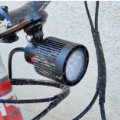Yocto-Visualization (for web) in your own web page
 Three weeks ago, we showed you how to integrate your own web page into Yocto-Visualization (for web). This week we explain how to do the opposite, i.e. integrate Yocto-Visualization (for web) into web pages served by an arbitrary web server.
Three weeks ago, we showed you how to integrate your own web page into Yocto-Visualization (for web). This week we explain how to do the opposite, i.e. integrate Yocto-Visualization (for web) into web pages served by an arbitrary web server.
| No comment yet | Read more... |
How to easily build a test bench for lights
 This week we have built a small test bench to determine the autonomy of several bike lights. This post, quite short, aims to show you how to build this bench very quickly using Yoctopuce modules.
This week we have built a small test bench to determine the autonomy of several bike lights. This post, quite short, aims to show you how to build this bench very quickly using Yoctopuce modules.
| No comment yet | Read more... |
Using an I2C infrared camera
![]() There are now small infrared cameras in the form of break-out boards that are very affordable and easy to integrate into automation projects. Surprisingly, they often use the I2C protocol to transfer data. Today, we show you how to use a Yocto-I2C to interface this type of camera.
There are now small infrared cameras in the form of break-out boards that are very affordable and easy to integrate into automation projects. Surprisingly, they often use the I2C protocol to transfer data. Today, we show you how to use a Yocto-I2C to interface this type of camera.
| No comment yet | Read more... |
Your own web page in Yocto-Visualization (for web)
![]() If you have already used Yocto-Visualization (for web) installer, you may have noticed an option that allows you to use your own web page as a container. This week we'd like to take a closer look at this intriguing feature.
If you have already used Yocto-Visualization (for web) installer, you may have noticed an option that allows you to use your own web page as a container. This week we'd like to take a closer look at this intriguing feature.
| No comment yet | Read more... |
Update of our PHP library
 This week we are updating our PHP programming library. We released the first version of this library in 2011. In 12 years, the PHP language has evolved a lot. So we update our library to take advantage of the improvements that have appeared since.
This week we are updating our PHP programming library. We released the first version of this library in 2011. In 12 years, the PHP language has evolved a lot. So we update our library to take advantage of the improvements that have appeared since.
| No comment yet | Read more... |
1 ... 10 ... 20 ... 25 26 27 28 29 30 31 32 33 34 35 ... 40 ... 50 ... 60 ... 70 ... 80 ... 90 ... 100 ... 110 ... 120 ... 130 ... 140 ... 150


